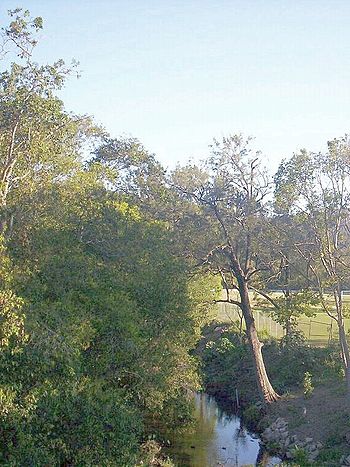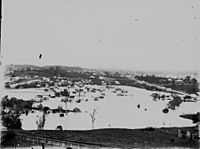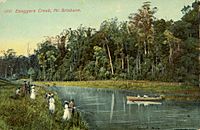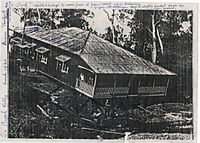Enoggera Creek facts for kids
Quick facts for kids Enoggera |
|
|---|---|

Enoggera Creek at The Gap, 2010
|
|
| Country | Australia |
| State | Queensland |
| Region | South East Queensland |
| City | Brisbane |
| Physical characteristics | |
| Main source | Enoggera Reservoir D'Aguilar Range 27°24′06″S 152°48′21″E / 27.4017°S 152.8059°E |
| River mouth | Breakfast Creek railway bridge at the intersection of the suburbs of Windsor, Albion and Bowen Hills 27°26′01″S 153°02′23″E / 27.4336°S 153.0397°E |
| Basin features | |
| Tributaries |
|
Enoggera Creek is a natural waterway that flows through the city of Brisbane in Queensland, Australia. It's an important part of the local environment and history.
Contents
Where Enoggera Creek Flows
Enoggera Creek starts high up in the D'Aguilar Range, near Mount Nebo. This area is part of Brisbane Forest Park. The creek's journey begins in the suburb of Enoggera Reservoir.
The Enoggera Dam
In the suburb of Enoggera Reservoir, the creek is held back by the Enoggera Dam. This dam creates a large body of water. After the dam, the creek winds its way towards the south-east.
Journey Through Suburbs
As it leaves the quiet parkland, Enoggera Creek flows through many Brisbane suburbs. These include The Gap, Ashgrove, Alderley, Newmarket, Red Hill, Kelvin Grove, Wilston, Herston, Windsor, and Bowen Hills.
Joining Other Creeks
Another creek called Ithaca Creek flows from Mount Coot-tha. It joins Enoggera Creek where the suburbs of Ashgrove, Red Hill, and Newmarket meet.
Becoming Breakfast Creek
Enoggera Creek officially changes its name to Breakfast Creek near a railway bridge. This bridge is located where the suburbs of Windsor, Bowen Hills, and Albion meet. Breakfast Creek then continues its journey until it flows into the larger Brisbane River.
Protecting the Creek
A community group called Save Our Waterways Now works hard to keep Enoggera Creek healthy. They help to restore and protect the creek's natural environment.
A Look Back in Time
Enoggera Creek has seen some big floods over the years. Major floods happened in 1893 and during the 1974 Brisbane flood. These floods were so powerful that they washed away many houses along the creek.
Images for kids
-
Relocating a house from St Johns Wood to Ashgrove, 1934




